Sandalops
Sandalops melancholicus
The sandal-eye squid
Richard E. Young and Katharina M. Mangold (1922-2003)Sandalops contains one recognized species. Voss, et al. (1992), however, suggest that 3-4 species exist.
Introduction
Sandalops melancholicus is a small squid. Maximum known size is about 110 mm ML. It is most easily recognized by the shape and method of attachment of the short fins. It occurs circumglobally in tropical and subtropical waters and at depths within the mesopelagic zone.
Brief diagnosis:
A taoniin...
- with tubular eyes as juvenile.
- with contiguous ocular photophores.
- with short, broad vanes of gladius with matching fins.
- without tubercules at funnel-mantle fusion.
Characteristics
- Tentacles
- Tentacular clubs with suckers only.
- Two series of suckers and pads on distal 1/2 of tentacular stalk.
- Head
- Beaks: Descriptions can be found here: Lower beak; upper beak.
- Beaks: Descriptions can be found here: Lower beak; upper beak.
- Funnel
- Funnel organ: Dorsal pad with two large triangular flaps.
- Funnel valve absent.
- Mantle
- Tubercles absent at funnel-mantle fusion.
- Tubercles absent at funnel-mantle fusion.
- Fins
- Fins short, oval to round.
- Posterior insertion of fins does not reach end of gladius (i.e. fins subterminal).
- Anterior insertion at broadest point on vanes of gladius (i.e., fins attach to posterolateral margins of lanceola).
- Photophores
- Two ocular photophores (one large, one small) on each eye are contiguous.*
- Arm tip photophores absent.
 Click on an image to view larger version & data in a new window
Click on an image to view larger version & data in a new window
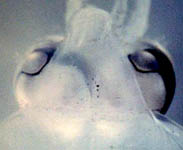
Figure. Left - Anteroventral view of the ocular photophores of Sandalops sp. a, mature male, 102 mm ML. Drawing from Voss (1980, p. 387, fig. 6d). Right - Anteroventral view of the oclar photophores of S. melancholicus, Hawaiian waters. Photograph by R. Young.
*Unusual in family; found also in Liguriella.
Comments
The eyes of juveniles are tubular, a feature shared only with Taonius. Also, the short, broad vanes of the gladius (see drawing for character no. 5 above) are distinctive and of considerable help in identifying damaged squid. Characteristics are from Voss (1980).
Life history
Paralarvae are found in the upper few hundred meters of the ocean (epipelagic zone) (see Vertical Distribution) and have eyes that are laterally compressed and possess a "rostrum" (see photograph to the right). Both features aid in concealment of the eye which, along with the digestive gland complex, are opaque structures in an otherwise transparent squid. The generic and common names of this squid are drawn from the shape of the paralarval eye as seen in illustration below of the holotype from Chun, 1910.
In Hawaiian waters, at 5.6 mm ML, the paralarva has small clubs, with a single chromatophore on the club's aboral surface; the dorsal head and eyes have 3 chromatophores as does the ventral head and eyes (one chromatophore is hidden by the funnel). The mantle has five small chromatophores dorsally and two ventrally and a pair of large chromatophores near the posterior tip of the mantle.

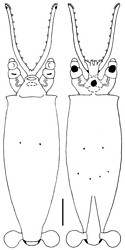
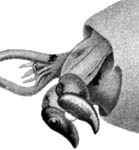
Figure. S. melancholicus, paralarvae. Left - Dorsal and ventral views , 5.6 mm ML, Hawaiian waters. Note the small tentacular clubs and the sparse pigmentation. Drawing by R. young. Middle -Side view of the paralarval head of S. melancholicus, holotype, 11.5 mm ML. Drawing modified from Chun (1910). Right - Side view of the paralarval head of S. melancholicus, Hawaiian waters. Photograph by R. Young.
The juvenile develops tubular eyes during its occupancy of the upper mesopelagic (=twilight) zone. The head is tilted with respect to the body axis and the eyes apparently, in life, are directed vertically upward toward the brightest downwelling light. Two photophores conceal the ventral silhouette of each eye.
The subadult is found in lower mesopelagic depths and has nearly hemispherical eyes (Young, 1975).

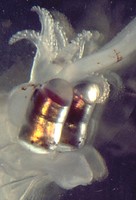
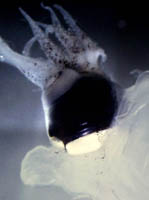
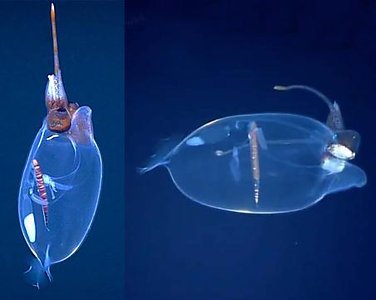
Figure.S. melancholicus. Heads: Left - Side view of the head of a juvenile , Hawaiian waters, showing tubular eyes. Right - Side view of a subadult, Hawaiian waters, showing near-hemispherical eyes. Photographs by R. Young. In situ photos: Two different individuals, each with eyes approaching the adult shape. Video frames from an ROV operating from NOAA Ship OKEANOS EXPLORER at 700 m depth (left) and 746 m (right). Photograph shows natural orientations; note vertical position of digestive gland in both.


Figure. Dorsal view of a mature male S. melancholicus. Drawing from Voss, 1980, p. 387, fig. 6a.
Large subadult females are heavily pigmented and their tentacles are absent with only a slight scar indicating where the tentacles once were.
Distribution
Vertical distribution
This squid undergoes ontogenetic descent. As it reaches greater depths with increasing age, the morphology of the eye changes greatly (see Life History).

Figure. Chart of the vertical distribution of S. melancholicus from Hawaiian waters, taken with both opening/closing and open trawls. Circle with black filling- Night capture. Circle with white filling- Day capture. Circles represent the modal depth of the trawl regardless of trawl type. Bars with circles- Trawl fishing-range of open/closing trawls. Bars without circles- Depth range of oblique trawl (solid bar- night capture; dashed bar- day or twilight capture). Chart modified from Young (1975).
Geographical distribution
The type locality is off Tristan da Cunha Island, South Atlantic.
References
Lu, C. C. and M. R. Clarke. 1974. Two new species of cranchiid cephalopods from the North Atlantic, Uranoteuthis bijucifera n. gen., n. sp. And Galiteuthis triluminosa n. sp. J. Mar. Biol. Ass. U.K. 54: 985-994.
Nesis, K. N. 1982/87. Abridged key to the cephalopod mollusks of the world's ocean. 385+ii pp. Light and Food Industry Publishing House, Moscow. (In Russian.). Translated into English by B. S. Levitov, ed. by L. A. Burgess (1987), Cephalopods of the world. T. F. H. Publications, Neptune City, NJ, 351pp.
Voss, N. A. 1980. A generic revision of the Cranchiidae (Cephalopoda; Oegopsida). Bull. Mar. Sci. 30: 365-412.
Voss N. A., S. J. Stephen and Zh. Dong 1992. Family Cranchiidae Prosch, 1849. Smithson. Contr. Zool., 513: 187-210.
Young, R. E. 1975. Transitory eye shapes and the vertical distribution of two midwater squids. Pac. Sci. 29: 243-255.
Title Illustrations

| Scientific Name | Sandalops melancholicus |
|---|---|
| Location | off Hawaii |
| Life Cycle Stage | Juvenile |
| View | Side |
| Image Use |
 This media file is licensed under the Creative Commons Attribution-NonCommercial License - Version 3.0. This media file is licensed under the Creative Commons Attribution-NonCommercial License - Version 3.0.
|
| Copyright |
© 1996

|
About This Page
Drawings by Voss, 1980 are printed with the Permission of the Bulletin of Marine Science.

University of Hawaii, Honolulu, HI, USA
Katharina M. Mangold (1922-2003)

Laboratoire Arago, Banyuls-Sur-Mer, France
Page copyright © 2017 and Katharina M. Mangold (1922-2003)
 Page: Tree of Life
Sandalops . Sandalops melancholicus . The sandal-eye squid.
Authored by
Richard E. Young and Katharina M. Mangold (1922-2003).
The TEXT of this page is licensed under the
Creative Commons Attribution-NonCommercial License - Version 3.0. Note that images and other media
featured on this page are each governed by their own license, and they may or may not be available
for reuse. Click on an image or a media link to access the media data window, which provides the
relevant licensing information. For the general terms and conditions of ToL material reuse and
redistribution, please see the Tree of Life Copyright
Policies.
Page: Tree of Life
Sandalops . Sandalops melancholicus . The sandal-eye squid.
Authored by
Richard E. Young and Katharina M. Mangold (1922-2003).
The TEXT of this page is licensed under the
Creative Commons Attribution-NonCommercial License - Version 3.0. Note that images and other media
featured on this page are each governed by their own license, and they may or may not be available
for reuse. Click on an image or a media link to access the media data window, which provides the
relevant licensing information. For the general terms and conditions of ToL material reuse and
redistribution, please see the Tree of Life Copyright
Policies.
- Content changed 10 October 2017
Citing this page:
Young, Richard E. and Katharina M. Mangold (1922-2003). 2017. Sandalops . Sandalops melancholicus . The sandal-eye squid. Version 10 October 2017 (under construction). http://tolweb.org/Sandalops_melancholicus/19551/2017.10.10 in The Tree of Life Web Project, http://tolweb.org/










 Go to quick links
Go to quick search
Go to navigation for this section of the ToL site
Go to detailed links for the ToL site
Go to quick links
Go to quick search
Go to navigation for this section of the ToL site
Go to detailed links for the ToL site